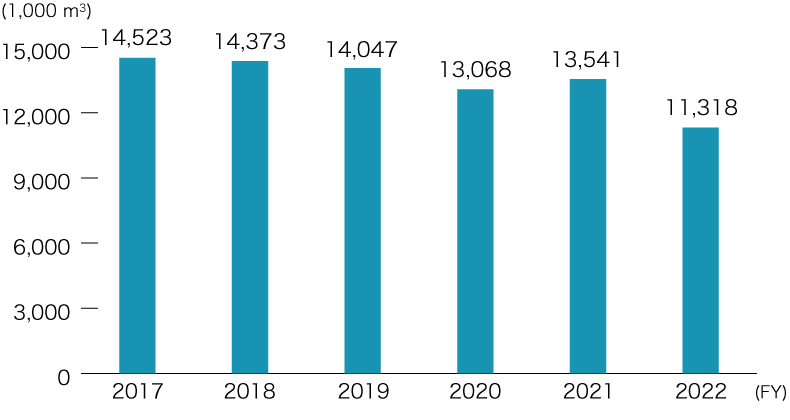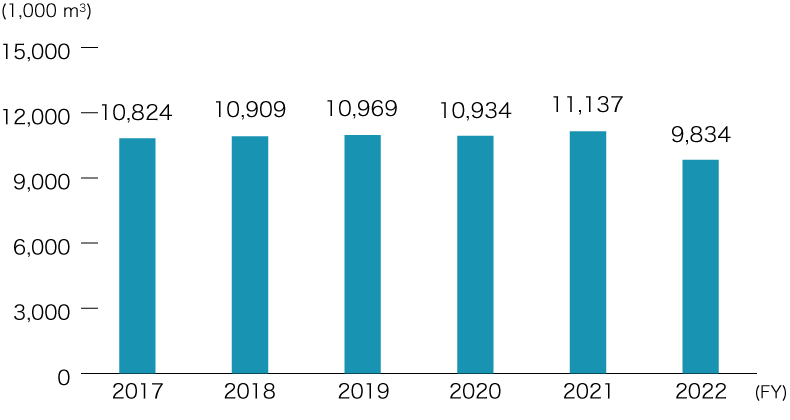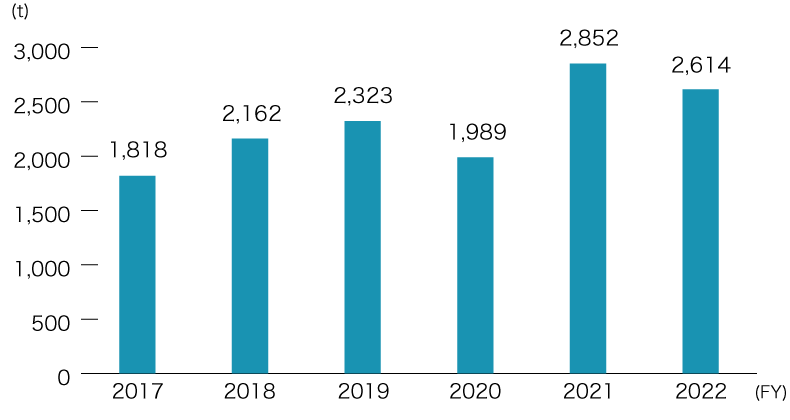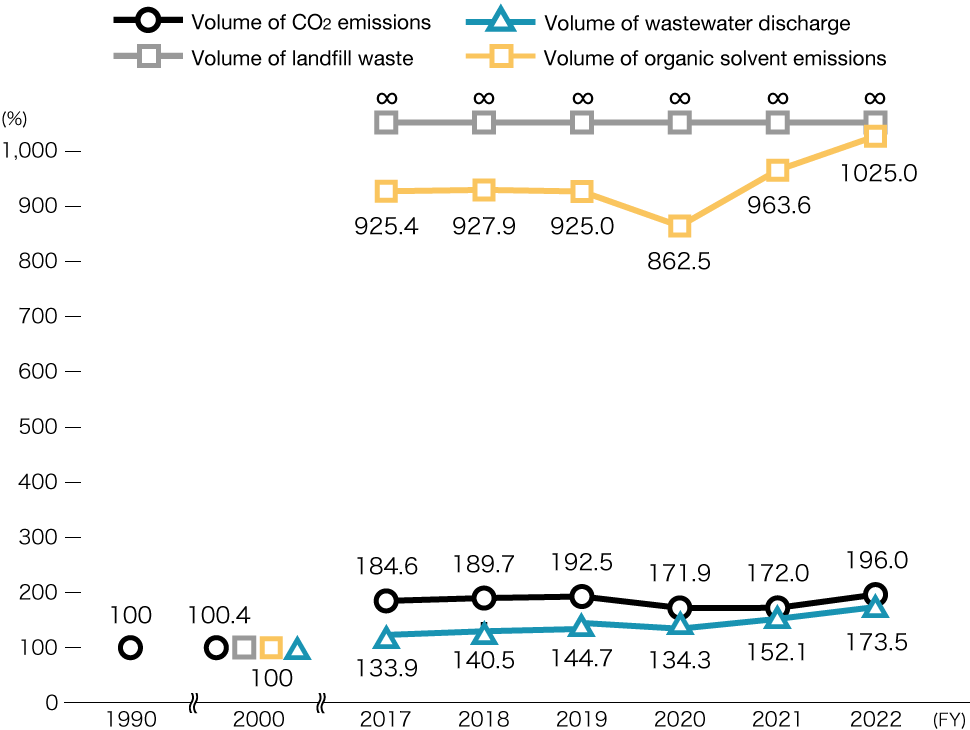Global Environmental Data
Ecology [Strengthening of our environmental management system]
- E ●
- S -
- G -
Global Environmental Data
The Sumitomo Rubber Group is striving to reduce greenhouse gas (GHG) emissions based on targets identified for emissions from production bases as well as from office and other non-production bases.
Volume of CO2 Emissions (Scope 1, Scope 2)*1
(t-CO2e)
| 2018 | 2019 | 2020 | 2021 | 2022 | |
|---|---|---|---|---|---|
| Scope 1 | 400,000 | 404,000 | 367,000 | 398,000 | 377,000 |
| Scope 2 (location) | 701,000 | 681,000 | 632,000 | 710,000 | 668,000 |
| Scope 2 (market) | — | — | — | — | 471,000 |
| Total (location) | 1,101,000 | 1,085,000 | 999,000 | 1,108,000 | 1,045,000 |
| Total (market) | — | — | — | — | 848,000 |
Volume of CO2 Emissions (Scope 3)
(t-CO2e)
| 2018 | 2019 | 2020 | 2021 | 2022 | |
|---|---|---|---|---|---|
| Category 1: Purchased Goods and Services | 1,830,819 | 1,325,414 | 1,671,425 | 5,801,146 | 5,072,885 |
| Category 2: Capital Goods | 213,274 | 185,432 | 133,734 | 45,228 | 45,850 |
| Category 3: Fuel- and Energy-Related Activities Not Included in Scope 1 and Scope 2 | 54,233 | 53,522 | 47,754 | 119,748 | 153,552 |
| Category 4: Upstream Transportation and Distribution | 182,136 | 192,508 | 166,533 | 375,377 | 381,815 |
| Category 5: Waste Generated in Operations | 1,316 | 1,917 | 560 | 19,222 | 19,196 |
| Category 6: Business Travel | 3,632 | 3,235 | 975 | 5,207 | 5,247 |
| Category 7: Employee Commuting | 941 | 978 | 942 | 17,295 | 17,243 |
| Category 8: Upstream Leased Assets | 0 | 0 | 0 | 0 | 0 |
| Category 9: Downstream Transportation and Distribution | 127,875 | 134,891 | 116,749 | 5,364 | 5,071 |
| Category 10: Processing of Sold Products | 0 | 0 | 0 | 0 | 0 |
| Category 11: Use of Sold Products | 18,779,072 | 19,707,858 | 17,079,335 | 33,559,808 | 32,869,605 |
| Category 12: End-of-Life Treatment of Sold Products | 96,082 | 96,211 | 84,391 | 927,587 | 896,702 |
| Category 13: Downstream Leased Assets | 706 | 778 | 778 | 72,696 | 3,327 |
| Category 14: Franchises | 0 | 0 | 0 | 0 | 0 |
| Category 15: Investments | 6,836 | 7,262 | 6,701 | 0 | 0 |
| Total | 21,296,922 | 21,710,006 | 19,309,877 | 40,948,679 | 39,470,493 |
*Categories 8, 10, 14 and 15 emissions are excluded from calculations (Category 15 emissions are included in figures for fiscal 2022 and later)
*Figures for fiscal 2021 or earlier: Calculation methods were determined in reference to The Japan Automobile Tyre Manufacturers Association (JATMA) Guideline Ver. 2.0. CO2 emission factors used were chosen from among those presented in the “Database of Environmental Impact Indicators for the Calculation of Greenhouse Gas (GHG) Emissions, etc., from Organizations through Their Supply Chains” issued by the Ministry of the Environment; Figures for fiscal 2022: Calculated in reference to the “Basic Guideline on the Calculation of GHG Emissions from Supply Chains Ver. 2.5” issued by the Ministry of the Environment. CO2 emission factors used were chosen from among those presented in “IDEA Ver. 2.3” issued by National Institute of Advanced Industrial Science and Technology, the “Database of Environmental Impact Indicators for the Calculation of Greenhouse Gas (GHG) Emissions, etc., from Organizations through Their Supply Chains Ver. 3.3” issued by the Ministry of the Environment, the “Calculation Guideline for Tire’s Life Cycle CO2 Emissions Ver. 3.0.1” issued by JATMA, and other materials.
Volume of Water Usage

Volume of Wastewater Discharge

Volume of Landfill Waste

Scope of Calculation
- Domestic factories
- Shirakawa, Nagoya, Izumiotsu, Miyazaki, Ichijima, Kakogawa
- Overseas factories
- Indonesia, Changshu (China), Hunan (China), Thailand, Brazil, South Africa, USA, Turkey, Thailand (natural rubber processing), Zhongshan (China), Vietnam, Malaysia, Switzerland, Thailand (tennis balls), Philippines, Slovenia
- Domestic affiliate factories
- Dunlop Retread Service, Ltd. (Ono Factory and Hokkaido Factory), SRI Engineering, Ltd. (Seishin Business Base and Kakogawa Business Base), Nakata Engineering, Ltd., Dunlop Golf Club, Ltd.
- Non-production bases
- Head Office, Technical Centers, offices, sales companies, logistics warehouses, Tire Proving Ground, sports gyms, golf courses, etc.
*1CO2 emissions are calculated using based on the “Guide for Calculating Greenhouse Gas Emissions,” published by the Japan Rubber Manufacturers Association. CO2 emission factors published by electricity companies are applied to domestic electricity consumption. CO2 emission factors for overseas electricity consumption are based on a WRI/WBCSD GHG Protocol Initiative Calculation Tool.
Basic Concept on Environmental Accounting
- The Sumitomo Rubber Group
The Sumitomo Rubber Group aims to promote corporate activities that give due consideration to environmental concerns while maintaining a favorable relationship with society. To this end, we have introduced environmental accounting.
Environmental accounting is one of the viable frameworks for quantitatively assessing the results of business efforts to preserve the environment. The Sumitomo Rubber Group is engaged in the measurement of operational costs and other factors in accordance with guidelines issued by the Ministry of the Environment.
In order to push ahead with environmental preservation initiatives in an efficient and effective manner, it is essential to promote the robust disclosure of environmental information in mutual collaboration with government agencies, business corporations and consumers. In this regard, the Sumitomo Rubber Group not only utilizes environmental accounting as a management tool but also cherishes it as a tool for communications with stakeholders across society.
Fiscal 2022 Environmental Accounting
- The Sumitomo Rubber Group
Environmental Preservation Costs (millions of yen)
| Category | Fiscal 2022 | ||
|---|---|---|---|
| Investment | Expenses | ||
1. Costs incurred for activities undertaken within business bases |
Costs for desulfurization and wastewater treatment equipment, etc. | 1,194 | 2,550 |
2. Upstream and downstream costs |
Costs for disposal of waste tires and the commissioning of container packaging, etc. | 10 | 129 |
3. Administrative costs |
Costs for the maintenance of EMS, etc. | 0 | 123 |
4. R&D costs |
Costs for the development of eco-friendly products, etc. | 0 | 2,250 |
5. Costs for social contribution activities |
Costs for greening activities | 4 | 176 |
6. Other costs for environmental preservation |
0 | 21 | |
| Total | 1,208 | 5,250 | |
Environmental preservation costs incurred during fiscal 2022 consisted of approximately ¥1.2 billion in capital expenditures executed to prevent pollution (e.g., the installation of dust collectors and wastewater treatment equipment), curb global warming (e.g., energy saving measures) and promote resource recycling (e.g., installation of boilers fueled by waste tires and poly-sheet restoration equipment), as well as approximately ¥5.3 billion spent for facility maintenance and management, including that of cogeneration systems, waste tire-fueled boilers and coolant water circulation equipment.
Environmental Preservation Effects in Terms of Overall Reductions in CO2 and Waste Emissions (in comparison with the absence of improvement measures)
| Category | Item | Volume of year-on-year reductions |
|---|---|---|
| Global environmental preservation | CO2Volume of CO2 emissions (t-CO2) | 15,487 |
| Energy consumption volume in crude oil equivalent (kl) | 10,625 | |
| Volume of organic solvent emissions (t) | -4 | |
| Resource recycling | Volume of landfill waste (t) | Maintaining complete zero emissions |
| Volume of waste emissions (t) | 588 | |
| Volume of wastewater discharge (thousand m3) | 271 |
In fiscal 2022, our global environmental preservation activities resulted in reductions of approximately 15,000 tons in the volume of CO2 emissions as well as 11,000 kiloliters in the volume of energy consumption in crude oil equivalent, respectively. These achievements are attributable to the success of energy-saving efforts and the impact of lower production volume. On the other hand, the volume of organic solvent emissions increased 4 tons.
In terms of resource-recycling initiatives, our six factories in Japan achieved complete zero landfill waste* for the 18th consecutive year since fiscal 2005. Thus, these factories successfully maintained the complete zero emission status in terms of the volume of waste disposed of by direct landfill. In addition, the volume of waste emissions decreased 588 tons, while the volume of wastewater discharge fell 271,000 m3.
*A status defined as the complete diversion of landfill waste, meaning a 100% recycling rate and no waste sent directly to landfills. (The Group has defined the overall volume of waste disposed of for the purpose of recycling as the volume of recycled waste.)
Economic Effects of Environmental Preservation Measures (millions of yen)
| Category | Measures | Economic effects |
|---|---|---|
| Cost reductions via energy saving | Introduction of cogeneration systems, the implementation of energy-saving activities | 413 |
| Recycling and the reduction of bulk, etc. | Waste reduction and recycling, proceeds from the sale of valuables | 1,315 |
| Total | 1,728 | |
In fiscal 2022, the economic effects of environmental preservation measures consisted of approximately ¥0.4 billion arising from energy-saving activities and approximately ¥1.3 billion arising from recycling and the reduction of bulk, etc.
Environmental Efficiency in Fiscal 2022
- The Sumitomo Rubber Group
In fiscal 2022, environmental efficiency in terms of the volume of CO2 emissions, wastewater discharge and organic solvent emissions improved. This is attributable to an increase in production volume and a significant rise in net sales. In fiscal 2023, we will aim for even higher environmental efficiency in all the items named above, to this end pursuing ongoing efforts to curb environmental burden.
In addition, environmental efficiency in the volume of landfill waste remained unchanged due to the maintenance of complete zero landfill status.

Environmental efficiency = Sales / Environmental burden, with the value as of the benchmarking year specified below as 100.
Volume of CO2 emissions: Value recorded in 1990 = 100
Volume of wastewater discharge, the volume of landfill waste and the volume of organic solvent emissions: Values recorded in 2000 = 100